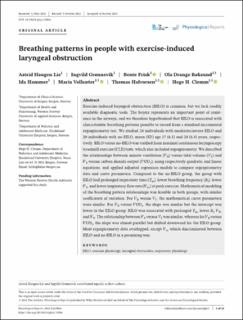| dc.contributor.author | Lie, Astrid Haugen | |
| dc.contributor.author | Grønnevik, Ingvild | |
| dc.contributor.author | Frisk, Bente | |
| dc.contributor.author | Røksund, Ola Drange | |
| dc.contributor.author | Hammer, Ida | |
| dc.contributor.author | Vollsæter, Maria | |
| dc.contributor.author | Halvorsen, Thomas | |
| dc.contributor.author | Clemm, Hege Synnøve Havstad | |
| dc.date.accessioned | 2022-02-03T09:53:00Z | |
| dc.date.available | 2022-02-03T09:53:00Z | |
| dc.date.created | 2021-12-10T10:38:46Z | |
| dc.date.issued | 2021 | |
| dc.identifier.citation | Lie, A. H., Grønnevik, I., Frisk, B., Røksund, O. D., Hammer, I., Vollsæter, M., . . . Clemm, H. H. (2021). Breathing patterns in people with exercise‐induced laryngeal obstruction. Physiological Reports, 9(22), e15086. | en_US |
| dc.identifier.issn | 2051-817X | |
| dc.identifier.uri | https://hdl.handle.net/11250/2976810 | |
| dc.description.abstract | Exercise-induced laryngeal obstruction (EILO) is common, but we lack readily available diagnostic tools. The larynx represents an important point of resistance in the airways, and we therefore hypothesized that EILO is associated with characteristic breathing patterns possible to record from a standard incremental ergospirometry test. We studied 24 individuals with moderate/severe EILO and 20 individuals with no-EILO, mean (SD) age 17 (6.1) and 24 (6.4) years, respectively. EILO versus no-EILO was verified from maximal continuous laryngoscopy treadmill exercise (CLE) tests, which also included ergospirometry. We described the relationships between minute ventilation (V̇_E) versus tidal volume (V_T) and V̇_E versus carbon dioxide output (V̇ CO2), using respectively quadratic and linear equations, and applied adjusted regression models to compare ergospirometry data and curve parameters. Compared to the no-EILO group, the group with EILO had prolonged inspiratory time (T_in), lower breathing frequency (B_f), lower V̇_E, and lower inspiratory flow rate (V̇_in) at peak exercise. Mathematical modeling of the breathing pattern relationships was feasible in both groups, with similar coefficients of variation. For V̇_E versus V_T, the mathematical curve parameters were similar. For V̇_E versus V̇ CO2, the slope was similar but the intercept was lower in the EILO group. EILO was associated with prolonged T_in, lower B_f , V̇_E, and V̇_E. The relationship between V̇_E versus V_T was similar, whereas for V̇_E versus V̇ CO2, the slope was almost parallel but shifted downward for the EILO group. Most ergospirometry data overlapped, except V̇_in which discriminated between EILO and no-EILO in a promising way. | en_US |
| dc.language.iso | eng | en_US |
| dc.publisher | Wiley | en_US |
| dc.rights | Navngivelse 4.0 Internasjonal | * |
| dc.rights.uri | http://creativecommons.org/licenses/by/4.0/deed.no | * |
| dc.title | Breathing patterns in people with exercise-induced laryngeal obstruction | en_US |
| dc.type | Peer reviewed | en_US |
| dc.type | Journal article | en_US |
| dc.description.version | publishedVersion | en_US |
| dc.rights.holder | © 2021 The Authors. | en_US |
| dc.subject.nsi | VDP::Medisinske Fag: 700::Klinisk medisinske fag: 750 | en_US |
| dc.source.volume | 9 | en_US |
| dc.source.journal | Physiological Reports | en_US |
| dc.source.issue | 22 | en_US |
| dc.identifier.doi | 10.14814/phy2.15086 | |
| dc.identifier.cristin | 1966969 | |
| dc.source.articlenumber | e15086 | en_US |
| cristin.ispublished | true | |
| cristin.fulltext | original | |
| cristin.qualitycode | 1 | |

